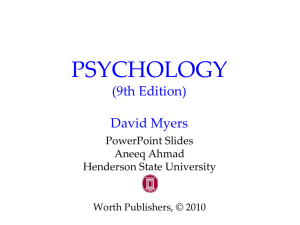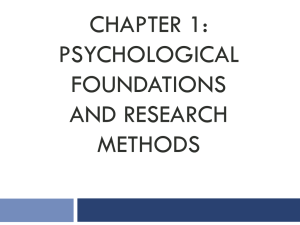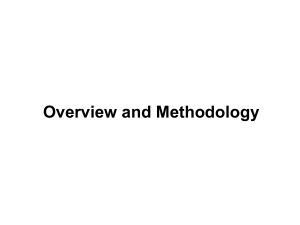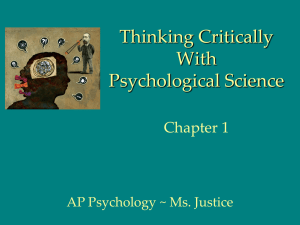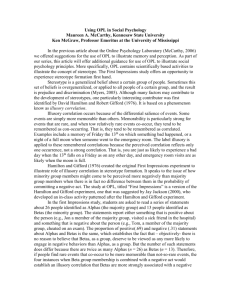Welcome to OCR Psychology
advertisement
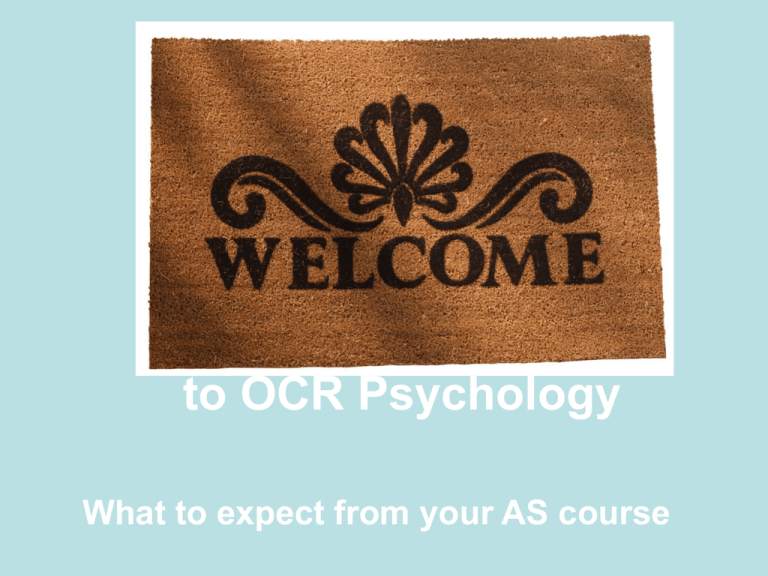
to OCR Psychology What to expect from your AS course Units of study AS Unit G541: Psychological Investigations • This unit is 30% of your total AS psychology and consists of a 1 hour written paper marked out of 60. • Although you will have to learn four sections for this paper, you will only be asked questions on three of the sections. The four sections are: • self report • experiment • observation • correlation Self Report • A self report is any method which involves asking a participant about their feelings, attitudes, beliefs and so on. Examples of self reports are questionnaires and interviews but note that self reports are often used as a way of gaining participants responses in observational studies and experiments. • Questionnaires are a type of self report method which consist of a set of questions usually in a highly structured written form. • Questionnaires can contain both open questions and closed questions and participants record their own answers. • Interviews are a type of spoken questionnaire where the interviewer records the responses. Interviews can be structured whereby there is a predetermined set of questions or unstructured whereby no questions are decided in advance. Experiment • An experiment is a research method used by psychologists which involves the manipulation of variables in order to discover cause and effect. It differs from non-experimental methods in that it involves the deliberate manipulation of one variable, while trying to keep all other variables constant. • The two main types of 'true' experiments are laboratory experiments and field experiments. • When psychologists carry out experiments they use one of three basic experimental designs to investigate the effects of an independent variable on a dependent variable. These are the independent measures design, the repeated measures design and the matched pairs design. • Before researchers carry out experiments they operationalise the variables and create hypotheses. A hypothesis is a testable, predictive statement. • Experiments produce quantitative data which can be analysed statistically. For this part of the course you need to be aware of descriptive statistics including measure of central tendency and bar charts. • Follow this link for a full evaluation of this method. Observation • All types of research involve some element of observation. It is not just observational studies that use observation. For example, when we use self report measures we observe the responses of the participants, when we carry out experiments we observe the behaviour of our participants and so on. • A full evaluation of this method can be found by following this link. Correlation • Correlation refers to a measure of how strongly two or more variables are related to each other. • A positive correlation means that high values of one variable are associated with high values of the other. Or if you like, the variables increase together. • A negative correlation means that high values of one variable are associated with low values of the other. Or if you like, as one variable increases the other decreases. Note that like a positive correlation, a negative correlation still indicates that some kind of relationship exists. • If there is no correlation between two variables they are said to be uncorrelated. Correlation • What type of correlation do these scatter graphs represent? • Correlations are expressed as a correlation coefficient which ranges from +1 to -1, with 0 indicating no correlation at all. • Click on this link for further evaluation, pay specific attention to the cause and effect problem. Units of study AS Unit G542 Core Studies • This unit is 70% of your total AS psychology and consists of a 2 hour written paper marked out of 120. The question paper has three sections. • Section A requires you to answer short questions related to each of the 15 core studies. • Section B requires you to answer one question, which requires considerable detail of one core study. • Section C requires you to answer one question from a choice of two focusing on approaches, issues and methods. Core studies (cognitive approach) • Baron-Cohen et al. (autism) Baron-Cohen, S., Jollife, T., Mortimore, C. & Robertson, M. (1997) Another advanced test of theory of mind: evidence from very high functioning adults with autism or Asperger syndrome. • Loftus and Palmer (eyewitness testimony) Loftus, E.F. & Palmer, J.C. (1974) Reconstruction of auto-mobile destruction: An example of the interaction between language and memory. • Savage-Rumbaugh et al. (animal language) Savage-Rumbaugh, S., MacDonald, K., Sevcik, R. A., Hopkins, W. D. and Rubert, E. (1986) Spontaneous symbol acquisition and communication use by pygmy chimpanzees (Pan paniscus) Core studies (developmental psychology) • Samuel and Bryant (conservation) Samuel, J. and Bryant, P. (1984) Asking only one question in the conservation experiment • Bandura, Ross and Ross (aggression) Bandura, A., Ross, D. & Ross, S.A. (1961) Transmission of aggression through imitation of aggressive models • Freud (Little Hans) Freud, S. (1909) Analysis of a phobia of a five year old boy. In The Pelican Freud Library (1977), Vol 8, Case Histories 1, pages 169-306 Core Studies (individual differences) • Rosenhan (sane in insane places) Rosenhan, D.L. (1973) On being sane in insane places. • Thigpen and Cleckley (Multiple Personality Disorder) Thigpen, C.H. & Cleckley, H. (1954) A case of multiple personality. • Griffiths (gambling) Griffiths, M. D. (1994) The role of cognitive bias and skill in fruit machine gambling. Core Studies (physiological psychology) • Maguire et al. (brain scans) Maguire, E. A., Gadian, N. G., Johnsrude, I. S., Good, C. D., Ashburner, J., Frackowiak, R. S., & Fith, C. D. (2000) Navigation-related structural changes in the hippocampi of taxi drivers. • Dement and Kleitman (sleep and dreaming) Dement, W. & Kleitman, N. (1957) The relation of eye movements during sleep to dream activity: An objective method for the study of dreaming. • Sperry (split brain) Sperry, R.W. (1968) Hemisphere deconnection and unity in consciousness. Core studies (social psychology) • Reicher and Haslam (BBC prison study) Reicher, S. & Halsam, S. A. (2006) Rethinking the psychology of tyranny. The BBC prison study. • Milgram (obedience) Milgram. S (1963) Behavioural Study of Obedience. • Piliavin et al. (subway Samaritan) Piliavin, I.M., Rodin, J.A. & Piliavin, J. (1969) Good Samaritanism: An underground phenomenon? Cognitive Psychology • Cognitive psychology studies our mental processes or cognitions. These mental processes that cognitive psychologists focus on include memory, perception, thinking and language. • The main assumption of the cognitive approach is that information received from our senses is processed by the brain and that this processing directs how we behave or at least justifies how we behave the way that we do. • Cognitive processes are examples of hypothetical constructs. That is, we cannot directly see processes such as thinking but we can infer what a person is thinking based on how they act. • Cognitive psychology has been influenced by developments in computer science and analogies are often made between how a computer works and how we process information. Based on this computer analogy cognitive psychology is interested in how the brain inputs, stores and outputs information. Developmental Psychology • Developmental psychology is interested in discovering the psychological processes of development. The three core studies in this section all focus on how children develop. It is worth noting that developmental psychologists also study adulthood too. • A main assumption of the developmental approach is that cognitive, emotional and behavioural development is an ongoing process and that such changes result from an interaction of nature and nurture.

